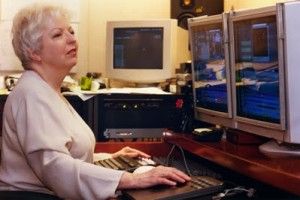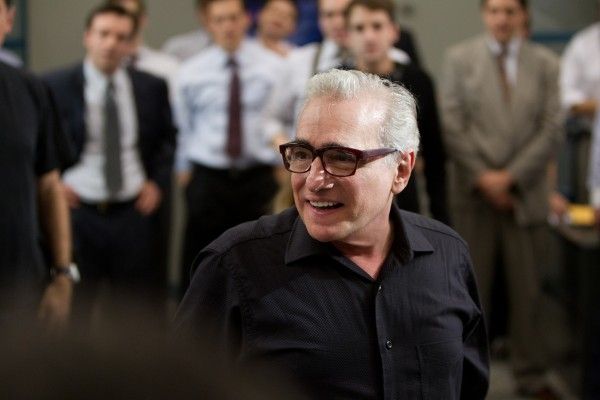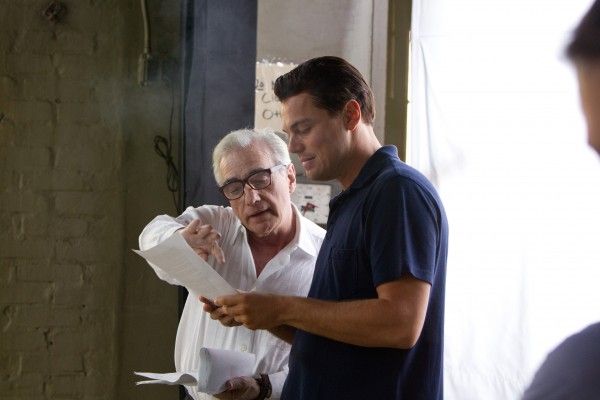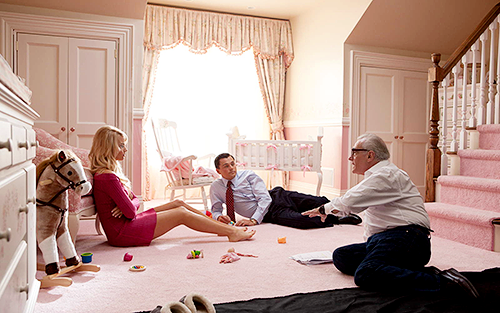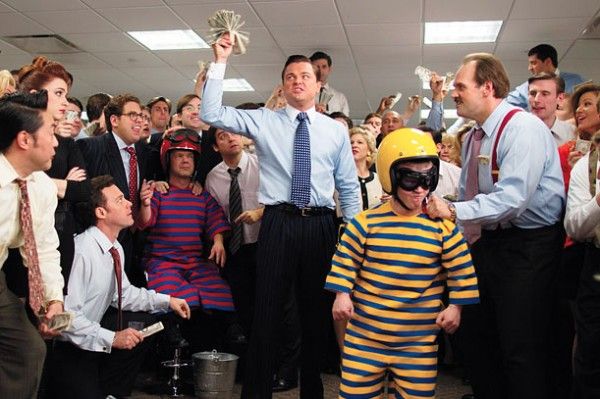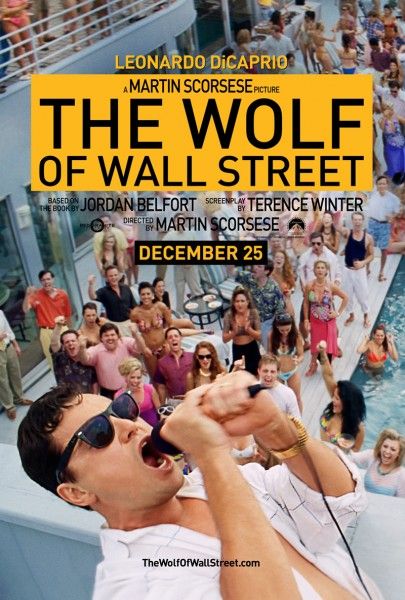Martin Scorsese‘s The Wolf of Wall Street is now in theaters, and for those who aren’t familiar with the film, it’s based on the memoir of Jordan Belfort, and stars Leonardo DiCaprio as the hard-partying, drug-addicted stockbroker who was indicted in 1998 for security fraud and money laundering and served a 22-month federal prison stretch. The film also stars Jonah Hill, Margot Robbie, Rob Reiner, Jon Bernthal, and Matthew McConaughey. For more on the movie, watch the trailer.
A few days ago, I landed an exclusive interview with Scorsese's longtime editor Thelma Schoonmaker. As a huge fan of her work, it was very cool to be able to talk to her. During the interview she discussed when she made the switch to cutting digitally, the original four-hour cut of The Wolf of Wall Street (and whether we'll ever get to see it), the back-and-forth they had with the MPAA over the theatrical cut of the film, whether it was a tough edit, her memories of working on Goodfellas and Casino, why she doesn't work with other filmmakers, and a lot more.
Collider: I’m going to start by saying I’ve been a fan of your work for a very long time and it’s really cool to finally get to talk to you.
THELMA SCHOONMAKER: [Laughs] Thank you so much.
Going backwards a little bit, I’m assuming you’re editing on Avid or some system, I’m just curious when you made the digital switch?
SCHOONMAKER: I made it on Casino and I was a very bad girl. I didn’t want to do it and the producer told me I had to do it, and I was very grumpy. I had a wonderful trainer who came to work with me and he made me put a quarter in a jar every time I said, “I could do this easier on film.” [Laughs] Then finally about two weeks in I just clicked in and I was off, because it is faster. I experiment a lot more now. I can make four edits for Marty of a scene instead of one just by copying it. In a second I can copy it. On film I used to have to, if I wanted to show him a different edit, I ‘d have to take it apart, hang it in the bin, remember how I did it, re cut it and then if he didn’t like that go back and remember how I had constructed it before. So now I’m fearless about improvising and coming up with different ideas, which is great. So even though I was very bad about it in the beginning [laughs] I completely converted.
What system were you using back then?
SCHOONMAKER: Lightworks, I’m still using Lightworks, which is an English system. It’s a wonderful system because it still retains some of the qualities of flatbed editing. It has a controller device that you can use, which is similar to what we used to use on the flat bed and I love it. It lost its market share at one point to Avid, but it’s still a viable company and they’ve worked with us all along. They were terrific on Hugo with 3D they devised all kinds of things for us. But, you know, it’s similar to Avid.
I’m personally not an editor, I use a very basic program for my video editing, nothing like what you guys all use.
SCHOONMAKER: Anyone can edit now, right? It’s wild.
Yeah, the fact that I can edit, that says something. Jumping into Wolf of Wall Street, there was a lot of talk that the first cut of the movie was so much longer and I’m definitely curious was the assembly cut closer to four hours?
SCHOONMAKER: No, more than the assembly, it was an edit. It was four hours, yeah. And a lot of people loved it at that length, but you can’t distribute a movie that length so we shaved it down very, very carefully. And we screen over and over again to make sure the film is working or how it’s working, and we ask people what they think and get cards from people. We’re constantly refining it and that’s how we did it. I didn’t think we could do it, frankly. I really said to Marty, “We’ll never get an hour out of this movie.” And we did by just working carefully, not losing whole scenes, but just shaving it down. And it was working just as well at three as it was at four. We’re lucky, because sometimes you have to drop whole scenes and that’s like cutting off your leg. In After Hours we dropped 45 minutes of wonderful improvised scenes; my favorite scenes, Marty’s favorite scene. We didn’t have to do that here, so it was lucky.
So I have to ask, how long was the first assembly cut?
SCHOONMAKER: Well there was never a first assembly cut. What I do is I- I mean, we never screened that. I cut each scene and then Marty and I start to work on it together, and then we have the first cut, which is the four hour cut. So I don’t know how long the assembly would have been before Marty and I worked on it together, because we never screened that.
So I’m going to speak for all Scorsese fans and especially for myself, who do I need to pay to see the four hour cut?
SCHOONMAKER: [Laughs] Well, listen, there is some talk about maybe trying to put some of the stuff we dropped as extras, maybe. I don’t know. Marty does not believe in director’s cuts. He believes in getting the cut that works for him and for the studio. He’ll fight to the death to get that. So he doesn’t believe in director's cuts, but then he’s been able to preserve his freedom. He’s learned how to do it. Some young filmmakers unfortunately don’t have the ability to resist attempts to maybe cut their films down unfairly. Maybe it’s fair to cut their films down, but Marty has learned how work the system. So he feels like he got what he wanted here and I don’t know if he’ll consider a director’s cut.
I completely understand where he’s coming from. The fact is when someone gives you a lot of money and they care- basically it's a two way street and filmmakers need to respect the business end. But at the same time, I think that things have changed a lot with the advent of Blu-ray and DVD where you can still release your movie and everyone can be happy, but then for fans maybe there can be a longer version.
SCHOONMAKER: Yeah, that’s good that there’s that freedom now. That really is good. That didn’t used to be the case, but we still want to get something that we feel comfortable with. It was just a lot of decisions and a lot of painful- not painful, but careful cutting down, and screening and screening, and making sure we hadn’t lost it. That’s the first thing I say to people who’ve seen it before, “Did we lose it?” [Laughs] And we hadn’t. They kept saying, “No, you haven’t.” I’m telling you I never thought we’d get an hour out of this movie, I really didn’t.
And I’m telling you with all sincerity I really want to see the four hour version. Let me just ask you this. Is there somewhere a file that exists so if you guys decided to show a four hour version it can still be done?
SCHOONMAKER: Oh yes, we always- see digitally you can keep everything. So I keep all my edits. I have the 4:00 edit, I have the 3:50 edit. I’ve got them all. Oh yeah, everything’s all here. We never lose it any more. On film, as I said, unless you made a dupe- and we did do that sometimes with our films. We would make a dupe print off it so we had a record of it at least. But now we can keep them all, I’ve got every single one of the cuts.
Please pass up the food chain that a lot of his fans and your fans would love to see the longer version even if it’s a one night only screening.
SCHOONMAKER: Oh, well that’s lovely. I will certainly pass that along. That’s very nice to hear.
I really mean that. I’ve got to jump backwards for a second. My favorite film is Goodfellas and while I have you on the phone I have to ask; how tough was that edit? Was there a longer cut of that movie? What do you remember about making that movie?
SCHOONMAKER: You know, the weird thing about Goodfellas was that it was so beautifully written and thought out because Nick Pileggi, of course, had already written a book called “Wise Guy”. We couldn’t use that title because somebody else, I think Brian de Palma, had already made a film using that so they had to change it to Goodfellas. So he had already written a book, then he and Marty wrote the script. So they already had a very tight thing to work with. And the script of Goodfellas is so tight we only dropped one thing, which is a little boy learning to drink espresso. It’s basically one or two shots and we felt like we didn’t need it. But that film was so beautifully thought out, even to where the freeze frames are, by the way. Marty had put in the script exactly where to freeze the frame. That is such brilliant directorial and editing thinking, which is why he is a wonderful editing director, because he thinks like an editor when he’s shooting. Anyway, that film I always say, was like we were riding a horse. It knew where it was going, it was so strong, and we were just riding and hoping to stay in the saddle [laughs], because it was so beautifully put together, constructed. Even with improvisations and all kinds of stuff, it was there. Sometimes in our movies we have to restructure or drop half of it, but not that movie. That one was really there. It was great.
Of course I have to ask about Casino, same sort of question. Was there a lot of stuff that didn’t make the final release?
SCHOONMAKER: Yes, yes. That was a much more sprawling film, and meant to be, so that was much more difficult to get down. You know, it is almost three hours long as well. Yeah, that was harder. It was a more complicated story, so that was harder and the re-writing of the voice over was hard. But we re-wrote the Goodfellas voiceover a lot too. You do when you’re using voice over in a movie. We re-wrote the voice over on Wolf a lot. But in Casino particularly we re-wrote it a lot and restructured a bit. It was harder to wrestle to the ground than Goodfellas, which man it just knew where it was going.
I’ve actually spoken to some people who consider Casino the better movie, and while I love both, I think they’re wrong.
SCHOONMAKER: Right, well it’s so funny because when Casino came out it was panned. Everybody said, “Oh, it’s not Goodfellas.” That’s right, it’s not Goodfellas, it’s Las Vegas. It’s a whole different thing. Now it has this huge cult following, which happens so much with Marty’s movies. It takes sometimes ten years- it took ten years for Raging Bull to be recognized. It was not a success when it came out, it took ten years and now look how it’s looked at. It’s looked at like a benchmark film. That happens a lot with Marty’s movies. Maybe that’s because they’re unusual, they’re out on the edge a bit and people don’t know what to make of them, and then with time they just are relished. Bringing out the Dead is the one we’re waiting to be recognized. I hear all these rumblings from all kinds of people who tell me how much they love Bringing out the Dead, but it’s never gotten its due.
Yeah, it definitely doesn’t have the same love as a lot of Scorsese films in terms of critical or buzz, if you will.
SCHOONMAKER: Yeah, well I think that’s because it’s about compassion and that’s not what most people expect [laughs]. Anyway it’s got many many fans, I’m discovering, all over the place. There’s a little rumble going on that’s maybe going to culminate in something, I hope [laughs].
Now I’m very curious. I have to ask you, everyone knows you edit for Scorsese, but I have to imagine there have been many people who have come to you over the years with offers to edit or work on other projects, so what’s your reasoning for not working with a lot of other filmmakers.
SCHOONMAKER: Ah, well, when you work with the best… [laughs]. First of all there’s usually a documentary, which we sometimes do in between features, that’s there. So I don’t have time to work for anybody else. And there’s always another feature coming. I’m very lucky. Most of my friends wait long times for jobs and also don’t get the chance to work on 20 films, like I have, with someone like Scorsese. I love working for him. I just would never- I can’t imagine working for anybody else. I have helped out, when he’s asked me to. I’ve helped out on films like Margaret, Kenny Lonergan’s film, and things like that. But I just love working for him. I don’t want to work for anybody else. But I do get offers all the time and I’m sorry I can accept them, but you know he’s the best. What can I say [laughs]?
I’m not knocking that at all in any way, shape or form, I’m just curious because I would imagine you’re offered other really high profile gigs.
SCHOONMAKER: Yes, I am. But less and less now because people begin to know now that there’s no point to even ask [laughs]. Believe me, I know so many editors who have trouble finding work, because it’s hard these days in the movie business. It’s very hard. And I’m so damn lucky to have had this incredible career. Can you imagine the number of wonderful films I’ve worked on? And then Scorsese introduced me to my husband, which gave me the ten happiest years of my life. I mean, how much more could you want [laughs]?
Oh that’s a whole other conversation. I could talk to you this whole time about Michael [Powell], but I don’t have that time so I will not open that.
SCHOONMAKER: I’m glad you’re a fan, though. That’s great.
I don’t know how you can’t be a fan of The Red Shoes and some of his films.
SCHOONMAKER: Oh I know, and such an influence on Marty, huge influence on Marty.
Yeah, again I could have spent this entire time talking about that. I’m choosing to walk a different road because there’s just no way to talk about everything in such a short period of time.
SCHOONMAKER: I know, I know.
Jumping back into Wolf of Wall Street, talk a little bit about the process of editing this one compared to some of the other films you’ve worked on. Was this one a challenge? Was this one of these things that came together real easy?
SCHOONMAKER: No, it was a challenge because Marty wanted it to be ferocious and he designed all these beautiful sequences. For example, the opening of the film was all designed shot by shot to cut to each shot. The throwing the doors, then cut to the still of a young boy, then to his Ferrari and inside the Ferrari where his wife is performing an act, and then the mansion. Those were all planned. Those shots were all planned to be cut together. But then you run into a brilliant scene like the lunch with Mark Hanna, which is Matthew McConaughey’s wonderful scene and you have to stop and relish it. So it was a different rhythm than most of our films. It was this rush and then stop, and then rush and then stop. But I’m hoping most people go with it. So that was a little bit of work to try and get the rhythm right. And the improvisations of course were wonderful to work with and they’re very hard because they don’t match always, but I love that so it wasn’t a negative struggle or anything. It was just a lot of hard work. But the film stayed basically in the same structure it always was. On The Departed we had to really restructure, but not this. It was different. It was so much improv and it was big, you know? It mushroomed up. So that was the job, to try and get on top of it and wrestle it to the ground [laughs].
I definitely want to ask you about the MPAA and what kind of battle you had with them on this one. I heard that there were some issues with maybe some of the crack sequences. I just heard some rumblings.
SCHOONMAKER: It was mainly the sexual explicitness that they were concerned about, but we worked very hand in glove with them. They like Marty’s movies [laughs] and they liked this one, so they were very amenable to giving us suggestions and we would respond to that. They gave us a couple of things, that was really good, if we would agree to cut other things. So we did have to censor quite a bit and Marty wanted to make that very clear. I think you can sort of tell if you look at the film again you’ll see where we were censoring it. For example, the woman in the bathroom, in the men’s bathroom, that beautifully constructed sequence Marty did of the madness, the full blown madness, in the elevator and all over the place. So we did have to- we dissolved so that we could make it obvious that we were jumping out something there. But listen, we worked with them and that was very helpful. In previous films the censorship has almost always been about violence, but we didn’t have that here so it was a different thing.
I want to sincerely say thank you for your time.
SCHOONMAKER: Thank you.
I hope you have a wonderful day and I hope to talk to you again in the future.
SCHOONMAKER: Thank you so much.

